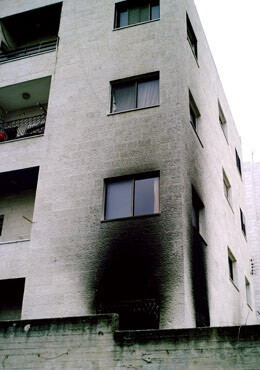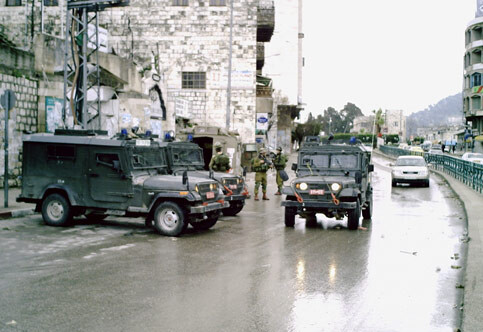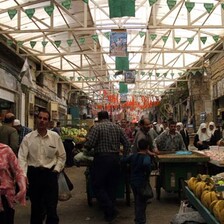
Two Israeli armoured vehicles block one of the main entrances to Nablus’ Old City. (Kirsten Sutherland)
Nablus, 26 February 2007
Dr. Ghassan Hamdan, Director of the Palestinian Medical Relief Society in Nablus, got up at five o’clock this morning after just two-and-a-half hours sleep. Until that time, he had been distributing medicines and food and providing emergency healthcare services to the residents of Nablus’ Old City, who had been under an Israeli-imposed curfew and thus forbidden from leaving their homes since early Sunday morning.
He was woken up by a call saying that a house just outside the Old City had been set on fire by Israeli soldiers and that there may be civilian casualties. When he arrived at the scene, he was told that Israeli troops had arrived at the residential apartment building at around 04:45 and had forced all the building’s residents out onto the street. One of the residents, Mona Tbeileh, was accused by soldiers of harbouring ‘wanted’ men in her home. Mona adamantly denied this, telling the soldiers that her husband was abroad and that she and her son were the only people in the ground-floor apartment. She told the soldiers that they could search the apartment as proof, and even offered herself as a human shield. They refused to search the apartment, and at around 05:15, they tossed explosives through the door of the apartment, setting it on fire. [1]

The burned exterior of the Tbeileh home. (Kirsten Sutherland)
Dr. Mustafa Barghouthi MP, who visited the family later the same day, said, “this is yet one more example of how the Israeli military believes it can act with impunity. This family’s home and belongings have been destroyed. And for what? What will they do now? No one will compensate them for the loss of their home. Nablus has returned to the days of 2002.”
Dr. Barghouthi was referring to the period during which Nablus spent almost 200 days under sustained curfew in 2002, when Nablus’ residents were forced to spend almost 80 percent of the hours during the period between June 18 to December 31 2002 indoors (often for 24-hour stretches) [2]. As such, the Nabulsi are well used to such forms of collective punishment.
This latest curfew began on Sunday 24 February, when up to 80 Israeli armoured vehicles and bulldozers invaded the city in the early hours of the morning in a so-called ‘arrest operation’. Local television and radio stations were taken over by Israeli troops, who aired messages calling for information on the whereabouts of five men. Houses were occupied and holes blasted through the walls in order to allow soldiers to move without venturing out onto the streets. One civilian was killed in his home by a shot to the neck; a further 20 people were injured by rubber bullet wounds.

Israeli military jeeps outside the Al-Watani Hospital in central Nablus. (Kirsten Sutherland)
The area around Nablus’ only two public hospitals, the Al-Watani and Rafidya Hospitals, was declared a closed military zone. When we visited the hospital in the heart of Nablus, its entrance was blocked by four military jeeps manned by approximately 16 soldiers, who stopped all ambulances and mobile clinics entering and exiting the hospital. [3]
In addition, schools and universities were forced to close as tens of thousands of students and teachers under curfew could not reach their places of work/study, and as educational institutions themselves were declared closed military zones. [4]
“The question no one is asking is whether it is necessary to put 250,000 people under curfew, to prevent them from reaching clinics and hospitals, and to shut down schools; no one is questioning this,” said Dr. Barghouthi.
This statement was put well in perspective when, whilst accompanying PMRS’ Mobile Clinic team around the Old City to bring essential medicines to chronic disease patients suffering from hypertension and diabetes, as well as milk powder for infants, bread, and other basic supplies, we came across two armoured vehicles blocking one of the main entrances to the Old City. Dwarfed beside these vehicles was a disabled man in a wheelchair who had been trying along with his brother to reach their home just metres inside the Old City for over an hour.

Dr. Ghassan attempts to pass armoured vehicles to accompany a disabled man and his brother to their house within the Old City. (Kirsten Sutherland)
After some insistence on our part, an international PMRS volunteer was told that she could take the disabled man to his house. “I can see that you’re not Arab” was the reason shouted to her by one of the soldiers. When she pointed out that there were steps leading up to the house and that she could not manage to carry the man by herself, she was allowed to accompany both men to their house on the condition that they remain inside and that she return immediately.
The tour further into the Old City revealed a place in stark contrast to the Nablus under more normal circumstances: a city whose narrow, winding alleyways teem with market sellers, vegetable carts, children playing football; a city famed for its hospitality, where people call out to you to drink coffee in their homes, or eat kunafe, a traditional Nabulsi desert, in their shops.
Today, we found a desert wasteland covered by a carpet of stones that had been aimed at the Israeli jeeps stationed menacingly throughout the Old City; makeshift ‘checkpoints’ consisting of tree branches and burning garbage cans put in place by residents in a vain attempt to disrupt the passage of Israeli jeeps; and faces peering down at the street from the windows above, some in fear, some simply in boredom.
As we were abruptly prevented from bringing powdered food to a five-year-old disabled child who eats nothing else by the presence of yet another Israeli armoured vehicle at the entrance to the street where the house lay, I asked mobile clinic driver and long-term PMRS volunteer, 27-year-old Taher Kosa, why he continuously risks his life to bring food and medicines to stranded families? “This is my form of struggle” he said. “Some people struggle through their education, some people struggle as journalists through the media. It’s my duty. And when you have colleagues who dedicate their lives to helping other people and who are always the first at any scene no matter how dangerous, it’s such an inspiration that you want to follow their example.”
This is the spirit which constantly leaves visitors in awe of the Palestinian people. The Israeli Occupation, characterised daily by stories like that of Nablus today, will enter its 40th year this year. Yet despite massive military, political and economic pressures; as Palestinian society nears collapse under their weight; and in the face of continued high-level failures by the international community to demand an end to Israel’s occupation, the inspiration drawn from within keeps Palestinians going in their struggle to live in peace, freedom and dignity.
Related Links
Endnotes
[1] In breach of Article 13.2 of the Protocol Additional to the Geneva Conventions of 12 August 1949, and Relating to the Protection of Victims of Non-International Armed Conflicts (Protocol II): “The civilian population as such, as well as individual civilians, shall not be the object of attack. Acts or threats of violence the primary purpose of which is to spread terror among the civilian population are prohibited.” It is also in breach of Article 53 of the Geneva Convention relative to the Protection of Civilian Persons in Time of War: “Any destruction by the Occupying Power of real or personal property belonging individually or collectively to private persons, or to the State, or to other public authorities, or to social or cooperative organizations, is prohibited, except where such destruction is rendered absolutely necessary by military operations.”
[2] See World Bank. October 2004. Four Years - Intifada, closures and Palestinian Economic Crisis: An Assessment. Page 2.
[3] In breach of Article 18 of the Geneva Convention relative to the Protection of Civilian Persons in Time of War: “Civilian hospitals organized to give care to the wounded and sick, the infirm and maternity cases, may in no circumstances be the object of attack, but shall at all times be respected and protected by the Parties to the conflict”; Article 5 Protocol Additional to the Geneva Conventions of 12 August 1949, and Relating to the Protection of Victims of Non-International Armed Conflicts (Protocol II): “[…] The following provisions shall be respected as a minimum with regard to persons deprived of their liberty for reasons related to the armed conflict, whether they are interned or detained: (a) The wounded and the sick shall be treated in accordance with Article 7; (b) The persons referred to in this paragraph shall, to the same extent as the local civilian population, be provided with food and drinking water and be afforded safeguards as regards health and hygiene and protection against the rigours of the climate and the dangers of the armed conflict”; and Article 7 of the latter convention: “1. All the wounded, sick and shipwrecked, whether or not they have taken part in the armed conflict, shall be respected and protected”; and “2. In all circumstances they shall be treated humanely and shall receive, to the fullest extent practicable and with the least possible delay, the medical care and attention required by their condition. There shall be no distinction among them founded on any grounds other than medical ones.”
[4] In breach of Article 50 of the Geneva Convention relative to the Protection of Civilian Persons in Time of War: “The Occupying Power shall, with the cooperation of the national and local authorities, facilitate the proper working of all institutions devoted to the care and education of children.”

